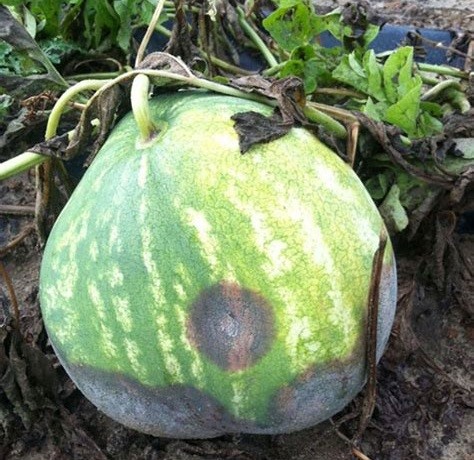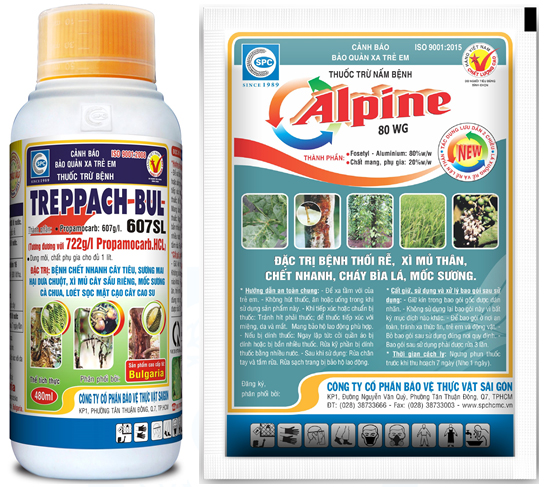|
Downy mildew disease on melon
08/12/2021
Ph.D. Nguyen Minh Tuyen Currently, melons are grown on a fairly large area in Vietnam, they are plants of high economic value. Melons are being consumed by society in large quantities and often in the form of vegetables and fruits. However, in the production process, farmers often face many diseases. In particular, late blight (somewhere called downy mildew) is one of the most dangerous diseases to melons. Late blight has caused crop failure, increased costs and hindered melon production in many regions. * Symptoms and effects: On the leaves, the disease initially causes the leaves to turn pale and shrivel, then dry out. In humid conditions, where new lesions are lightly covered with a thin layer of white fungus, especially the underside of the leaves, the leaves and adjacent parts of the plant also become black and wet. The disease is easy to spread and the garden of melons are rotten in patches. On the fruit, the lesions are usually oval in shape and in humid conditions the lesions are lightly covered with a layer of white fungus, after which the fruit rots. The disease not only causes fruit rot when melons are still in the field, but also continues to cause damage during transportation and storage after harvest. * Pathogens and conditions of development: Disease caused by the Phytophthora sp fungus. Conditions of development: - Before planting, The garden must not be cleaned of the remnants of the previous crop.. - The garden has been planted with melons, and plants with the same host continuously, or planted near the garden of tomatoes, potatoes, or some other upland crops such as melons, tomatoes, red peppers... - Planting with infected varieties, planting with high density, fertilizing with excess nitrogen, lacking organic and micro-nutrient fertilizers, so the garden is dense. - Water management is not good, gardening is often wet. - Winter-Spring crop, usually with cool or slightly cold temperatures, high air humidity, little sunshine, a lot of fog at night are optimal conditions for the disease to develop... * Effective prevention measures: - Sanitize and destroy disease remnants in the fields and gardens before planting, especially in the previous crop with plants with the same host as melons, tomatoes, potatoes, red peppers, etc. - Find disease resistant varieties to plant - Plant with appropriate density, avoid planting too thick, easy to cause dense and damp in the garden. - Raise high beds, cover with membranes and water appropriately so that the garden is not wet often. - Balanced fertilizing, with enough organic, supplemented with semimacro and trace elements to help increase the resistance of plants such as foliar fertilizer POLY FEED 15-15-30 at the fruiting-blooming stage. - Rotate with other crops if the garden regularly grows melons, tomatoes, potatoes. - When the weather conditions are cloudy, less sunny, more foggy, humid and cool, it is necessary to prevent it first with the following products: TREPPACH BUL 607SL, or ALPINE 80WG - Should be sprayed twice 5-7 days apart when the disease just appears in the field. |
To prevent, in addition to plowing and burying weed seeds, collecting weed stalks and stumps left after tilling the land to burn, not letting weeds produce seeds in production fields, etc., the use of chemical products is still a measure. optimal because of its ability to thoroughly kill weeds, reduce labor and take advantage of more time than manual weeding.
Miner has the scientific name Phyllocnistis citrella Staint., family Phyllocnistidae, order Lepidoptera. The miner occurs in many countries in the tropics and subtropics. The main host of the miner is the citrus family - Rutaceae. In addition, the miner also attacks mangosteen and some other plants.
Adult is a small planthopper, with a body 2-3 mm long, the whole body is ash gray, slightly greenish, the wings are opaque with many small brown spots.Eggs are oval, 0.3 mm long, have a pointed end and are attached directly to the leaf surface, leaf axils.
Green bugs specialize in the fruit of citrus groups (oranges, tangerines, lemons, grapefruits, kumquats...), some people call them orange bugs, or orange suckers. Their scientific name is Rhynchocoris poseidon or Rhynchocoris humeralis.
In Vietnam, yellow leaf curl disease is very common on papaya trees, especially the disease is often severe in areas of high and continuous planting, areas with hot and arid climates. The disease has significantly reduced the yield and quality of papaya. Gardens that are infected early when the plants are young may not yield. However, up to now, many gardeners still do not know the cause and how to fix it.
Spider mites are common pests on citrus trees, especially in hot and dry climates that are suitable for spiders to grow and cause severe damage.The group of harmful spiders is usually very small in size, unlike the natural enemy spiders.
This group includes species that are generally very small in size, causing damage by sucking plant sap (on leaves, fruits, branches, stems).
There are many species of mealybugs present on the group of Oranges,Tangerines,Grapefruits and Lemons (Citrus), which can be divided into 2 groups:
+ Group of sticky mealybugs with common varieties such as Lepidosaphes, Aonidiella, Coccus and Saissetia.
+ Group of flower mealybugs with common genera and species such as Pseudococcus, Planococcus and Icerya purchasi.
Dry branches and berries disease often appear to be common damage on coffee gardens during the rainy season. The disease causes death of branchs, dry fruit, severely affects the canopy structure and coffee yield if not paid attention to prevention.
Pink disease commonly causes diseases on rubber plantations in the rainy season, especially on garden from 4-8 years old. This year, rubber has to go through a period of severe drought, weakening the tree, so now in tnshe rainy season it is easy to get infected. Therefore, it is necessary to pay attention to good management to avoid affecting the garden.
In recent years, the area of citrus has been expanded because it is a fruit tree with high economic efficiency. However, in order to sell at a high price, not only in quality but consumers also require the external beauty of the fruit, so pest management on citrus is a matter of great concern to farmers. The hot season is a favorable condition for thrips to develop and cause damage, affecting the commercial value of fruit.
- Headquarters
- SAIGON PLANT PROTECTION JOINT STOCK COMPANY
- RQ 1, Nguyen Van Quy St., Tan Thuan Ward, HCM City
- Tax code: 0300632232
- Tel: (028) 38 733 295 - 38 732 077
- Fax: (028) 38 733 003 - 38 733 391
- Website: www.spchcmc.vn - Email: info@spchcmc.vn
- SAIGON PLANT PROTECTION COMPANY
- SAIGON PLANT PROTECTION JOINT STOCK ENTERPRISE
- Lot C1-C3 Hiep Phuoc Industrial Park, Hiep Phuoc Commune, HCM City
- Tel: (028) 3873 4089 - Fax: (028) 3873 4086
- Affiliated Unit
-
- Quick Links
- Home
- About us
- Career Opportunities













